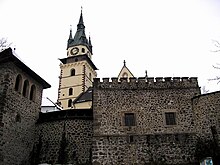| Revision as of 18:16, 15 March 2006 editPaul Martin (talk | contribs)1,502 editsm fixed error← Previous edit | Revision as of 08:28, 25 March 2006 edit undoTankred (talk | contribs)7,836 editsm link to plague columnNext edit → | ||
| Line 8: | Line 8: | ||
| A mining settlement extracted abundant deposits of ] at least since the 13th century (in reality probably much earlier). The first written reference to the town dates back to ], when it was granted the royal ] privileges by ]. The town's mint is known to have existed already at that time. Since 1335 it coined golden "Kremnica ]s", which were used as international means of payment for their constantly high purity of gold. The mint was the most important and later the only mint in the ], in ] and in Slovakia. | A mining settlement extracted abundant deposits of ] at least since the 13th century (in reality probably much earlier). The first written reference to the town dates back to ], when it was granted the royal ] privileges by ]. The town's mint is known to have existed already at that time. Since 1335 it coined golden "Kremnica ]s", which were used as international means of payment for their constantly high purity of gold. The mint was the most important and later the only mint in the ], in ] and in Slovakia. | ||
| The ] built from the 13th till the 15th century towers over the town. The sites of interests also include the Museum of Coins and Medals, the Museum of Skiing and a historical central square with a monumental ] |
The ] built from the 13th till the 15th century towers over the town. The sites of interests also include the Museum of Coins and Medals, the Museum of Skiing and a historical central square with a monumental ] ]. The ] Church of St. Catherine hosts the popular European ] Festival. A 20-km long ], built in the ], is still working, supplying three hydroelectric power plants (one of them located 245 m below the ground). Forested mountains around the town offer plenty of ] and ] trails. | ||
| The ] is claimed to be in a nearby village of ''Krahule''. | The ] is claimed to be in a nearby village of ''Krahule''. | ||
Revision as of 08:28, 25 March 2006


Kremnica (German: Kremnitz, Hungarian: Körmöcbánya) is a town in central Slovakia. It has some 5.800 inhabitants. Site of the oldest still working mint in the world.
Kremnica (also called "Golden Kremnica") was among the major mining towns of the world during the Middle Ages and Modern Times period.
A mining settlement extracted abundant deposits of gold at least since the 13th century (in reality probably much earlier). The first written reference to the town dates back to 1328, when it was granted the royal town privileges by Charles I of Hungary. The town's mint is known to have existed already at that time. Since 1335 it coined golden "Kremnica ducats", which were used as international means of payment for their constantly high purity of gold. The mint was the most important and later the only mint in the Kingdom of Hungary, in Czechoslovakia and in Slovakia.
The castle built from the 13th till the 15th century towers over the town. The sites of interests also include the Museum of Coins and Medals, the Museum of Skiing and a historical central square with a monumental baroque plague column. The gothic Church of St. Catherine hosts the popular European Organ Festival. A 20-km long aqueduct, built in the 15th century, is still working, supplying three hydroelectric power plants (one of them located 245 m below the ground). Forested mountains around the town offer plenty of hiking and cross-country skiing trails.
The geographical center of Europe is claimed to be in a nearby village of Krahule.
This Slovakia-related article is a stub. You can help Misplaced Pages by expanding it. |